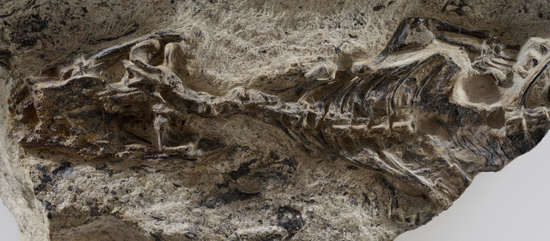The Mother of All Dragons – Megachirella wachtleri
A team of international scientists, including palaeontologists from Bristol University, Midwestern University (Arizona) and the University of Alberta, have identified the world’s oldest lizard fossil (Megachirella wachtleri), permitting fresh insight into the evolution of extant snakes and lizards (Squamata). Writing in the journal “Nature”, the researchers, including co-author Dr Massimo Bernardi from MUSE – Science Museum, Italy and University of Bristol’s School of Earth Sciences, built the largest dataset of reptiles ever assembled in order to assess where in the evolutionary tree of the Reptilia a fossil from the Dolomites of Italy should be placed.
The Holotype Specimen of Megachirella wachtleri
Picture credit: MUSE – Science Museum
Megachirella wachtleri
The fossil, consisting of an articulated partial specimen was discovered in marine sediments in the Dolomites of Italy and named Megachirella wachtleri in 2003. Although, found in marine sediment, the fossil, which represented the front portion of the animal, showed no adaptations to an aquatic existence. On the contrary, it had strong legs with claws and although small at around twenty centimetres in length, it was probably a capable climber. It was concluded that the carcass of this reptile had been washed out to sea following a storm.
An analysis in 2013 concluded that Megachirella wachtleri was a member of the Lepidosauromorpha, a group of diapsid reptiles defined as being closer to Squamata than to the Archosauria.
Lepidosaurs include modern snakes and lizards, many extinct forms of reptile and the Order Rhynchocephalia, once very diverse, but now only represented by the tuatara of New Zealand. This new research, which drew upon an enormous database of skeletal and molecular information about 129 different types of reptile, revealed that Megachirella had characteristics that are only found in the Squamata. It was concluded that M. wachtleri was a stem squamate – think of it as being the “the mother of all dragons”.
Co-author Dr Randall Nydam of the Midwestern University in Arizona stated:
“At first I did not think Megachirella was a true lizard, but the empirical evidence uncovered in this study is substantial and can lead to no other conclusion.”
The 240-million-year-old fossil, Megachirella wachtleri, is the most ancient ancestor of all modern lizards and snakes discovered to date. The study also found that geckoes are the earliest crown group squamates not iguanians as previously thought.
A Life Reconstruction of Megachirella wachtleri
Picture credit: Davide Bonadonna
Megachirella wachtleri on the Front Cover of “Nature”
The beautiful illustration of M. wachtleri produced by Davide Bonadonna is featured on the front cover of the journal Nature, which provides details of this scientific study.
The research team conclude that the Squamata probably evolved in the Late Permian and therefore, the ancestors of today’s snakes and lizards survived the most devastating mass extinction event known to science – the end Permian extinction.
Tiago Simões, lead author of the scientific paper and a PhD student at the University of Alberta (Canada), explained:
“The specimen is 75 million years older than what we thought were the oldest fossil lizards in the entire world and provides valuable information for understanding the evolution of both living and extinct squamates.”
10,000 Squamate Species
It has been estimated that there are around 10,000 species of lizards and snakes living today, twice as many different species as mammals. Despite this modern diversity, scientists did not know much about the early stages of their evolution.
Student Tiago Simões added:
“It is extraordinary when you realise you are answering long-standing questions about the origin of one of the largest groups of vertebrates on Earth.”
Co-author of the study, Dr Michael Caldwell from the University of Alberta, explained that fossils represent the only accurate window into the ancient story of life on our planet. The new understanding about Megachirella and its significance is but a point in deep geological time, it does tell us things about the evolution of lizards that we simply cannot learn from any of the extant species today.
Co-author Dr Massimo Bernardi from MUSE – Science Museum, Italy and University of Bristol’s School of Earth Sciences, commented upon the importance of such fossil specimens, stating:
“This is the story of the re-discovery of a specimen and highlights the importance of preserving naturalistic specimens in well maintained, publicly accessible collections.”
The scientific paper:
“The Origin of Squamates Revealed by a Middle Triassic Lizard from the Italian Alps” by T. Simões, M. Caldwell, M. Tałanda, M. Bernardi, A. Palci, O. Vernygora, F. Bernardini, L. Mancini and R. Nydam published in the journal Nature.
Everything Dinosaur acknowledges the help of a press release from Bristol University in the compilation of this article.
Visit the Everything Dinosaur website: Everything Dinosaur.








Leave A Comment